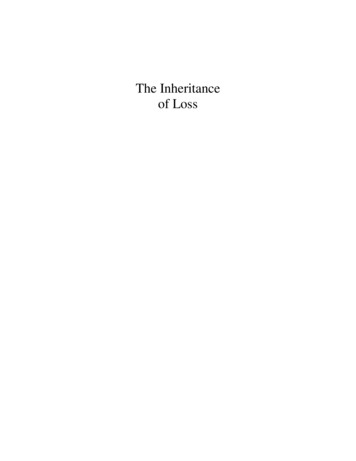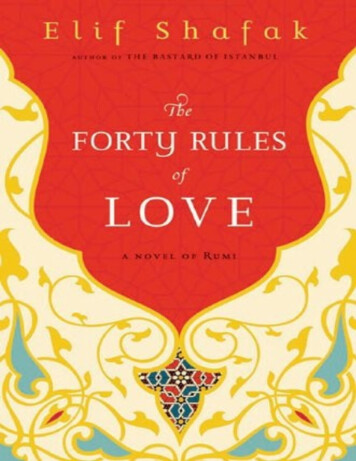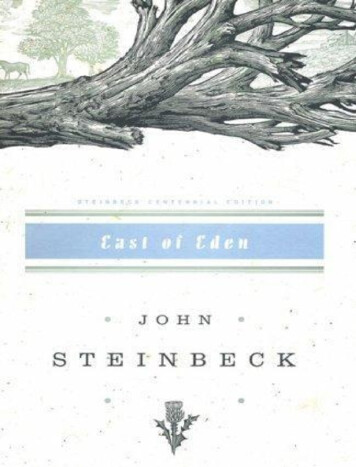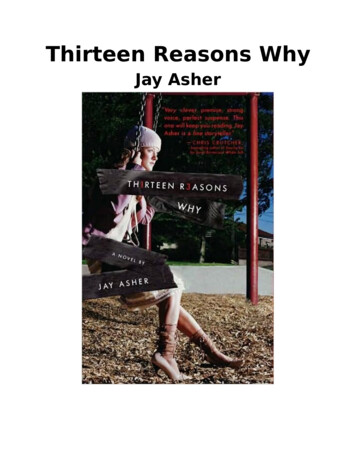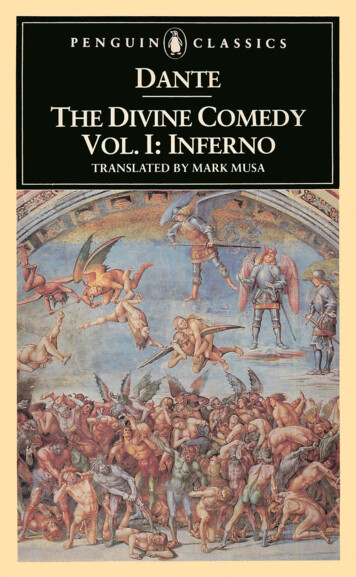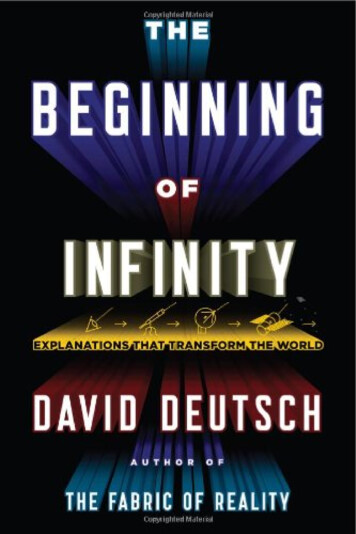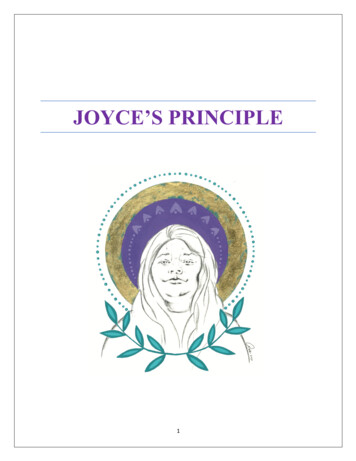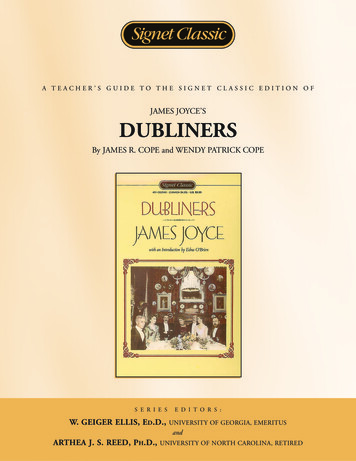
Transcription
A TEACHER’S GUIDE TO THE SIGNET CLASSIC EDITION OFJAMES JOYCE’SDUBLINERSBy JAMES R. COPE and WENDY PATRICK COPES E R I E SW. GEIGER ELLIS, ED.D.,E D I T O R S :UNIVERSITY OF GEORGIA, EMERITUSandARTHEA J. S. REED, PH.D.,UNIVERSITY OF NORTH CAROLINA, RETIRED
A Teacher’s Guide to the Signet Classic Edition of James Joyce’s Dubliners2INTRODUCTIONDubliners by James Joyce is a good reading choice for advanced level 12th-grade students. As his first published work offiction, Dubliners stands by itself both as an important piece of writing and as a forerunner of the experimental style thatJoyce would use so effectively in his later works. The fact that in Dubliners Joyce uses a more traditionally structured stylemakes the novel more accessible than his other works to advanced high school readers. The central theme of paralysis dueto the effects of outside forces and individual moral decay will be attractive to older adolescents who are struggling to findtheir places in a world where they are continually buffeted by outside forces and their own uncertainties.Students who not long ago were playing childhood games and undergoing childhood crushes will identify easily with thecharacters in the three stories in section one. In section two, these students, who are on the verge of graduating from highschool and experiencing the changes coming from this momentous event, will be able to connect strongly with the fearof change faced by Eveline (“Eveline”) while embracing the excitement of dreams for the future held by Jimmy (“After theRace”). The future is very important to adolescents, and Joyce’s glimpses of life in the third section will sound a warningthat decisions made early in life carry far-reaching consequences. Students searching for their place in the worldrelentlessly question the spoken and unspoken rules governing our existence. They will be able to relate to the charactersin section four who are bound by conventions and norms of which they are barely aware. Students will enjoy joiningJoyce’s unwavering examination of the most powerful institutions in his and our lives.In addition to the personal connections students will be able to make with Joyce’s stories, the book also lends itself to ahistorical study of Irish history, politics, and religion. Dubliners can be studied in an interdisciplinary unit in English andworld history. By studying Joyce’s world, students can better understand many of the forces that have shaped their own.The organization of this teacher’s guide begins with teaching ideas to use before reading starts. From there, the teachingideas follow the structure that Joyce gave the book in a letter to his publisher: Section I, Childhood, contains “The Sisters,” “An Encounter,” and “Araby” (the most anthologized of the stories). Section II, Adolescence, is made up of “Eveline,” “After the Race,” “Two Gallants,” and “The Boarding House.” Section III, Maturity, also is made up of four stories, “A Little Cloud,” “Counterparts,” “Clay,” and “A Painful Case.” Section IV, Public Life, is made up of “Ivy Day in the Committee Room,” “A Mother,” “Grace,” and the structurallydifferent “The Dead.”Each of these sections contains a synopsis and activities for before, while, and after reading. The activities help elucidatethe stories and tie them together. Also, there are suggestions for other works to consider. The teaching ideas are designedto involve students with Joyce’s central themes, characters, and styles while connecting all of them to students’ lives.INVESTIGATING THE IMPORTANCE OF JOYCE’S WRITINGThe originality of Joyce’s style and the influence he had on other writers make him one of the most important writers ofthe twentieth century. His importance is evident in the considerable amount of scholarly interest in his work. Theproblem in exploring the literary criticism is not in finding resources but rather in narrowing a focus to just a few works.Feshbach and Herman identify the following as some of the higher quality Joycean scholarship: Primary Bibliography—Slocum and Cahoon’s A Bibliography of James Joyce, 1882-1941. Secondary Bibliography—Deming’s A Bibliography of James Joyce Studies. Biographies—Ellmann’s James Joyce and Stanislaus Joyce’s My Brother’s Keeper and The Complete Dublin Diary. General Studies—Levin’s James Joyce: A Critical Introduction, Tindall’s A Reader’s Guide to James Joyce, andKenner’s Dublin’s Joyce.BEFORE READINGBecause so much of the book consists of “snapshots” of Dublin life in Joyce’s time (1882-1941), it is important to helpstudents understand its historical context. To make reading more fruitful, have students use the “Introduction” and“Bibliography” in the Signet Classic edition as a starting point for completing these assignments:
A Teacher’s Guide to the Signet Classic Edition of James Joyce’s Dubliners3Divide students into groups and assign each group one of the following topics to present orally to the class: Research Dublin’s size, economic structure, and place in Europe. How did/does Dublin compare to other Europeancapitals? What is the basis for the differences? How have these differences affected the Irish people? Research the politics of Joyce’s Ireland and compare and contrast them to our political system today. Compare andcontrast the colonial America’s relations with Great Britain to Ireland’s relationship with England. How is Ireland’scurrent political state similar to that described in Dubliners? How is Ireland’s current relationship with Englandrelated to the political climate of Joyce’s Dublin? Research the role religion played in life in Joyce’s Dublin. What effects has Catholicism had on the Irish today andin Joyce’s time? Research Joyce’s life and explain how growing up in Dublin affected him. Also, explain why he felt he had to leaveIreland to become a successful artist. Research the life and death of Charles Stewart Parnell. What were the planks in his political platform? How did heplan to accomplish his plans for Ireland? What effect did his political fall and ensuing death have on Irish politics?JOYCE’S CHRONOLOGY IN HISTORICAL CONTEXT(Garrett, Peter K., ed. Twentieth Century Interpretations of Dubliners: A Collection of Critical Essays. Englewood Cliffs,N.J.: Prentice-Hall, 1968.)In order by “Year”, “Joyce”, “The Age”1882—Joyce born, February 2. Phoenix Park murders in Dublin.1898-1902—Joyce attends University College, Dublin. The Boer War; death of Queen Victoria. Irish Literary Theatrefounded. Published: W. B. Yeats, The Wind Among the Reeds; Freud, The Interpretation of Dreams.1904—Joyce begins Dubliners, leaves Ireland with Nora Barnacle. Published: Conrad, Nostromo; James, The Golden Bowl.1907—Chamber Music published (poems written from 1902 onwards). J. M. Synge’s The Playboy of the Western World performed.1914- Serial publication of A Portrait of the Artist as a Young Man begins in February; Dubliners published in June. Joycebegins Ulysses. World War I begins.1916—Portrait published in book form. Easter rising in Ireland.1922—Ulysses published. T. S. Eliot’s The Waste Land published.1927-29—Joyce publishes early versions of Finnegan’s Wake as Work in Progress. Published: Yeats, The Tower and TheWinding Stair. New York stock market crash ushers in depression.1939—Finnegan’s Wake published. World War II begins with German invasion of Poland. Yeats and Freud die.1941—Joyce dies, January 13. Germany invades Russia; Japanese attack Pearl Harbor; USA enters war.STRUCTURE AND STYLE OF THE NOVELDubliners is not merely a group of short stories structured according to stages of human development. Joyce meantDubliners to be read as a novel of a city’s development, with its inhabitants growing from innocence to experience. In aletter to a prospective editor, Joyce wrote:My intention was to write a chapter of the moral history of my country, and I chose Dublin for the scene becausethat city seemed to me the centre of paralysis. I have tried to present it to the indifferent public under four ofits aspects: childhood, adolescence, maturity, and public life. The stories are arranged in this order. I have writtenit for the most part in a style of scrupulous meanness and with the conviction that he is a very bold man whodares to alter in the presentment, still more to deform, whatever he has seen and heard.(from Herbert Gorman, James Joyce, New York, 1940, V-iv.)
A Teacher’s Guide to the Signet Classic Edition of James Joyce’s Dubliners4Joyce’s role as recorder of the city develops the style in which Dubliners is written. He adopts an attitude of “scrupulousmeanness” toward his characters, in which Joyce balances sympathy and objectivity. This balance exhibits both factualinformation and sympathetic understanding of characters. Evidence of this style lies in Joyce’s tongue-in-cheek objectivity,subtle comment, careful crafting of tone and images, and demonstration of conflict in characters’ intentions and actions.To help students develop understanding and appreciation of Joyce’s structure and style, have them complete theseassignments: To immerse students in Joyce’s stylistic theory, have students develop “scrupulously mean” character portraits ofpeople from their own lives. Students should take extreme care in selecting people for their character portraits in orderto maintain the balance between realistic objectivity and sympathetic understanding. Even more challenging wouldbe a character portrait of themselves. As an extension of the previous activity, have students draw or paint a portrait that accomplishes the same objectiveas their written piece. Students may create a dramatic monologue which develops a realistic character using the concept of “scrupulousmeanness.” In preparing this monologue, students should consider elements such as costume, voice quality, andphysical presence which will contribute to character development as well as to the presentation’s dramatic quality.To examine Joyce’s writing choices more thoroughly, students can compare their “scrupulous meanness” in any of theseprojects to Joyce’s style during their reading of Dubliners.EPIPHANY IN JOYCE’S DUBLINERSJoyce often ironically exposes his characters to moments of self-awareness or awareness of the true nature of theirenvironment. Joyce called these moments “epiphanies,” adapting the religious term referring to the revelation of the infantJesus to the Magi. In Stephen Hero Joyce writes, “by an epiphany he (Stephen Daedalus) meant a sudden spiritualmanifestation, whether in the vulgarity of speech or of gesture or in a memorable phase of the mind itself ” (188). It is theflash in which the essential nature of a person, an object, or a moment is perceived, all at once. Joyce says, “its soul, itswhatness leaps to us from the vestment of its appearance.”Joyce often recorded his own epiphanies, then later used the idea of epiphany in Dubliners as a symbolic literary technique toreveal the paralysis of the city as well as the faults and shortcomings of its inhabitants. Joyce also used the epiphany as astructural device; rather than employing a traditional resolution, Joyce ends his stories with the epiphany in the form of aspeech (as in “The Sisters” and “Grace”), a gesture (“Two Gallants”), or a “memorable phase of the mind itself” (“Araby” and“The Dead”), because the reader’s revelation about the character’s condition satisfies Joyce’s purpose in writing the story.To make the concept of epiphany easier for students, have them select from these projects: Gather a collection of at least five popular songs whose lyrics deal with realizations of the artist or a character the artisthas created, and play the songs for the class. Make sure to highlight the moments of realization in your presentationand show similarities and differences between the way the narrator of each song handles his/her “epiphany.” Complete an artistic rendering (in sculpture, drawing, painting, or fabric arts, such as batik) of a moment that yourealized something important about yourself, your life, or those around you. Demonstrate (or build) a machine in which a certain part or motion of a part changes the motion or adds a newdimension to the original motion of a part. Be sure to explain how the “epiphanic” part changes the purpose of thebasic machine.SECTION I: CHILDHOODSYNOPSES“The Sisters” (1-11)A young boy must deal with the death of Father Flynn, his mentor, exposing him to others’ opinions of the priest.These force him to examine their relationship and cause him to see himself as an individual for the first time.
A Teacher’s Guide to the Signet Classic Edition of James Joyce’s Dubliners5“An Encounter” (12-22)Faced with boredom at school and spurred by excitement found in pulp magazine stories about the AmericanWild West, two young boys skip school to take a trip to “The Pigeon-house.” Their schoolboy lark and youthfulegocentricism are destroyed by an encounter with an aging pervert.“Araby” (23-30)A young boy experiences first love, a crush on a friend’s older sister. Because she is unable to go to the “splendidbazaar [Araby],” he promises to buy her a gift. This promise becomes the basis of a romantic quest. When hefinally arrives at Araby, his romantic illusions are shattered as he becomes aware of the pain and unfulfilleddreams of the adult world.CONNECTING THE STORIES TO STUDENTS’ LIVESA central theme in Section I is children’s sudden awareness that the adult world is not the place childhood dreams havemade it. To help students explore this theme and connect it to their own lives, have them consider the following questionsin journal writing or oral discussion: How is high school different from what you thought it would be when you were in middle school? How did you react the first time you discovered that someone you admired and looked up to had “feet of clay”? Howdid this realization affect your view of the world? Did you ever had a crush on someone older? What did you do in order to see them or be near them? At what pointdid you realize that your dream person was unobtainable? How did you react to this knowledge?SECTION IISYNOPSES“Eveline” (31-36)Eveline chooses the familiarity of a life in which she is mistreated by her abusive father and takes the place ofher dead mother in raising her younger siblings over the fear of change represented by starting a new life in anew country with the man who loves her.“After the Race” (36-44)A young gentleman (Jimmy) learns that he doesn’t have what it takes to succeed in his circle of sophisticated andglamorous international friends.“Two Gallants” (45-57)A not-so-young man (Lenehan) examines the shallowness and hopelessness of his life while killing time waitingfor his gigolo friend Corley to bilk money from a poor working girl.“The Boarding House” (58-66)The owner of a boarding house (Mrs. Mooney) wordlessly conspires with her daughter (Polly) to force Mr.Doran (Polly’s lover and a boarder in the house) to marry Polly.CONNECTING THE STORIES TO STUDENTS’ LIVESA central theme in Section II is paralysis. Characters are trapped in lives they abhor by events and forces they could controlas well as those beyond their control. In these stories adolescents and young adults become aware they are or will betrapped, creating in them moral or spiritual paralysis that prevents them from escaping or avoiding the trap. To connectthese stories to their lives, have students: List future goals and outline steps to achieve these goals; list outside support needed. Write about self-created
A Teacher’s Guide to the Signet Classic Edition of James Joyce’s Dubliners6obstacles as well as those created by outside forces. Interview a successful person. Develop interview questions in advance to discover how the individual achieved goal(s)and explore obstacles (internal and external) that had to be overcome. Write about leaving a familiar place for a new place (e.g., moved, changed schools). Discuss the power of familiarityand the frightening aspects of change. Respond to the following: Have you or someone you know tried to join a group that was too old? Has anyone triedto join your group who was too young or not as sophisticated as the group? What were the results of these efforts?SECTION IIISYNOPSES“A Little Cloud” (67-83)Little Chandler goes to a fancy bar to meet his old friend Gallaher whom he hasn’t seen in eight years. In thoseyears Gallaher has become a successful writer for a newspaper in London and Little Chandler has settled into amediocre job, marriage, and fatherhood. His reunion with Gallaher forces him to compare their two lives, andthis comparison makes him see himself as hopelessly trapped in a dull, depressing existence.“Counterparts” (84-97)Farrington is a lazy, incompetent copier and an abusive husband and father. He tries to escape the depression,rage, and hopelessness caused by the mess he has made of his job and homelife through liquid lunches anddrunken evenings out with the boys.“Clay” (98-106)Maria works in the kitchen of an industrial laundry. Because of her gentle nature and peace-making skills, sheis liked by everyone at the laundry. The high points of Maria’s life are her visits to Joe and his family. She wasJoe’s nanny, and his family is her only family. The story centers around her visit on Hallow’s Eve and illustratesthe emptiness in her life.“A Painful Case” (107-118)Mr. James Duffy was a man who “abhorred anything which betokened physical or mental disorder.” Thisabhorrence extended to any show of emotion or romantic love. He ended his only human relationship when herealized that Mrs. Sinico was in love with him and not just their intellectual discussions. Two years later he reada news article about Mrs. Sinico’s alcohol-related, accidental death. From the newspaper’s interview with herhusband and daughter, he realized the break up had destroyed her life. This realization leads to the epiphany thathe had missed out on his chance to love and be loved.CONNECTING THE STORIES TO STUDENTS’ LIVESIn Section III the theme of paralysis explores the world of mature adults who are aware of the trap(s) into which they havefallen and the spiritual and personal paralysis that led them there and keeps them there. Have students explore this theme’sconnection to their world by engaging in some of the following activities. Complete one of the following:- It’s unfair that is more popular than me because.- It’s unfair that made a better grade than me because.- It’s unfair that gets more recognition than me because.Examine this written response to determine how much of the unfairness is due to things you have or haven’t doneand how much is due to forces beyond your control.
A Teacher’s Guide to the Signet Classic Edition of James Joyce’s Dubliners7 Write about a recent argument or disagreement with a friend, parent, teacher, or other adult. Now write about it fromthe other person’s point of view and then from the point of view of an objective observer. Brainstorm a list of individuals who have dedicated their lives to the service of others. Discuss advantages anddisadvantages of living such a life. Respond to the following statement: “Love between man and man is impossible because there must not be sexualintercourse and friendship between man and woman is impossible because there must be sexual intercourse.” (112113) In writing describe the type of individual who would espouse such a philosophy.SECTION IVSYNOPSES“Ivy Day in the Committee Room” (119-138)This story takes place in a political committee room where several political canvassers have gathered at the endof a long, wet day of vote getting. They warm themselves by the small coal fire and bottles of stout. As theevening progresses, they discuss politics, each other, and the death of the great nationalist politician, Parnell.“A Mother” (139-154)This story is a war of wills between Mrs. Kearney and Mr. Holohan and the committee members of the “EireAbu Society.” The conflict revolves around the payment of eight guineas to her daughter Kathleen for herservices as an accompanist for a concert the society is planning. Mrs. Kearney throws herself into the promotionand organization of the concert. When the concert’s success is in doubt, Mrs. Kearney insists that Kathleen bepaid before she performs, delaying the start of the concert. The battle of wills ends when Mrs. Kearney refusesto let Kathleen play for the second half of the concert because she has only been paid half of her fee.“Grace” (155-182)Concerned over his drunken and dangerous behavior, Mr. Kernan’s friends conspire to reform him by takinghim to a men’s weekend-long religious retreat. After all their cajoling and his wife’s urging, he agrees to go. Themen he sees at the retreat and the priest’s businesslike message provide an ironic ending that illustrates the moralparalysis of Joyce’s Dublin.“The Dead” (183-236)The last and most significant of the stories takes place at the annual holiday dance held by Kate and JuliaMorkan and their niece Mary Jane. The story focuses on the perceptions of Gabriel Conroy, Kate and Julia’snephew. Over the course of the evening, Gabriel has jarring encounters with the party guests, his aunts, and hiswife Gretta, forcing him to view the world from a point of view other than his own egocentrism.This story crystallizes Joyce’s intent for the entire novel. It was written after the book was contracted forpublishing, as an afterthought. Gabriel’s epiphany illustrates Joyce’s “scrupulous meanness;” Gabriel realizes thatan objective viewpoint leads to true sympathy, created by the bond of human mortality.This final story is masterful in its structure; the pacing of events and the use of symbolic detail (such as the snow)draw the reader in like a vortex, growing narrower and faster towards its universal close.CONNECTING THE STORIES TO STUDENTS’ LIVESSection IV explores the paralysis of an entire community by examining the ways that individuals are held down by thefailure of political, religious, and social systems. Have students consider the following as mini research projects, journalentries, or discussion starters: Contact the office of one of your state or national representatives or senators and find out what paid and volunteerpositions they employ for their campaigns; and/or research the major campaign figures of each party in the lastpresidential campaign.
A Teacher’s Guide to the Signet Classic Edition of James Joyce’s Dubliners8 Discuss instances in which parents you know have unintentionally hurt their children by interfering in attempts toprotect them; and/or check magazines and newspapers for articles about overprotective, interfering parents of childand adolescent sports and entertainment celebrities. Tell about the first time you looked at your parents, grandparents, aunts, uncles, or other adults as individuals.Extend this discussion to looking at your best friend, boyfriend, or girlfriend as the center of his/her own worldinstead of as an important part of your world. Tell about a time you made a uninformed judgement about someone close to you. When you discovered the “rest ofthe story,” how did you react? How did the new information change your perceptions about that person? Aboutyourself?WHILE READINGSECTION ILANGUAGEJoyce’s diction is extremely important to his writing style in Dubliners. Not only does his word choice reflect the delicatebalance of “scrupulous meanness” Joyce is trying to obtain, but his careful selection of words also underlines the imagesand themes Joyce threads throughout the novel.To develop a keener awareness of Joyce’s subtle commentary, imagery, and diction, have students keep a stylistic journalduring their reading in which they note word choices, quotes, use of dialect, images (such as light and dark, motion andstillness, constraint and freedom), figurative language, and unfamiliar phrases. Students should keep notes of theirimpressions of and reactions to Joyce’s style in addition to page numbers of the information, definitions, and, mostimportantly, the effect Joyce’s style has on the development of the novel.A weekly discussion of students’ findings, with special emphasis on vocabulary, will develop their vocabulary skills andincrease their understanding of each story as well as the effect Joyce’s style has on the novel as a whole. This procedure canbe followed throughout all four sections of the book. Also, the “After Reading” sections contain quotations to highlightduring weekly discussions on style.In this first section, students should focus on religious vocabulary, especially the religious and secular connotations of thewords. Some of this vocabulary is as follows, with page numbers in parentheses:“The Sisters”—Catechism (1), simoniac (4), scrupulous (10)“An Encounter”—penitent (22), “Swaddlers” (15)“Araby”—litanies (25), chalice (25)DETAILED STUDY QUESTIONSBecause of the unfamiliar language and complex writing style used by Joyce, even advanced students may need assistancefollowing the plot. To give students the assistance they need, provide them with detailed study questions. These questions canbe used as class or group discussion starters, individual writing prompts, detailed study guides, a test review, or test items.“THE SISTERS” (1-11)1.What is old Cotter’s opinion of Father Flynn? (1-2)2.What was the boy’s relationship to Father Flynn? (2)3.What is the boy’s reaction to the news of the priest’s death and old Cotter’s scrutiny? (2-3)4.What are old Cotter’s and the uncle’s views on the benefits of the boys relationship with the priest? (2-3)5.What is the boy’s opinion of old Cotter? How has it changed? (2-3)
A Teacher’s Guide to the Signet Classic Edition of James Joyce’s Dubliners6.What did the priest die from? Describe the physical aspects of his illness. (3-4)7.When he realizes that Father Flynn is dead, what is the boy’s reaction? (5)8.What lessons did the priest teach the boy? (5-6)9.Who took care of the details of Father Flynn’s lying in state? (8)910. What was the beginning of Father Flynn’s ill health? (10)11. What happened to let everyone know that Father Flynn had become mentally unbalanced? (10-11)“AN ENCOUNTER” (12-22)1.Why does Joe Dillon always prove victorious in the mock Indian battles? Why is this ironic in light of his chosen future? (12)2.Why do the pulp magazines appeal to the narrator? (13)3.What does the narrator plan to break up the “weariness of school-life?” What is ironic about Leo not showing up? (14-15)4.What does the “ragged troop” calling them “swaddlers” tell you about the religious make up of Dublin? (15-16)5.What is the lure of the docks to the boys? (16)6.What does the narrator’s ideas about sailors with green eyes tell us about his education? (17)7.How does the man try to ingratiate himself to the boys? How do their answers demonstrate differences in theirpersonalities? (18-19)8.The man talks in “circles” around a few subjects. What do his speech patterns and the subjects he dwells on tell you abouthim? (19-21)9.Do you think the narrator’s fear of him is justified? Why or why not? (21-22)“ARABY” (23-30)1.Judging from the games the boys play, how old do you think the narrator is? (24)2.What is the mood of the story? How does Joyce establish it in the first few pages? (23-24)3.Would you describe the narrator’s feelings toward Mangan’s sister as realistic or romantic? Explain. (24-25)4.Why does the word Araby contain so much meaning for the narrator? Discuss the possibilities the word represents to him.(26-27)5.How are the results of the trip to Araby foreshadowed? (27-28)6.Why is the uncle late coming home Saturday night? (28)7.Why does he not buy anything at the young lady’s booth? (29-30)SECTION II: ADOLESCENCELANGUAGEIn Section II students should focus on the development of setting and characters in their journals. In discussion studentsshould note the detail with which Joyce develops setting and characters as well as the overall picture of Dublin createdthrough both.In discussing Joyce’s characters and his setting, students should attribute each of their notes on language and style to thecharacter or setting Joyce creates. Relate characters to settings: Which characters in “Adolescence” are most alike in thevocabulary used to describe them? Which settings relate to each other? What is Joyce’s purpose in placing these specificcharacters in these specific settings?
A Teacher’s Guide to the Signet Classic Edition of James Joyce’s Dubliners10“Eveline”—cretonne (31), quay (36)“After the Race”—remonstrative (38), deft (39), trepidation (40), deploring (41), torpid (42)“Two Gallants”—jauntily (46), rotundity (46), adroitness (46), eloquence (46), nimbly (46), vagrant (46),sauntered (51), pensively (52), obliquely (52), slatternly (54)“The Boarding House”—rakish (62), agitation (64), celibate (64), delirium (65), implacable (65), discomfiture (65)DETAILED STUDY QUESTIONS“EVELINE” (31-36)1.What was the children’s biggest worry while playing in the field? (31)2.Now that Eveline has decided to leave, what sort of things has she begun to notice? Why? (32)3.What are the advantages and disadvantages of her going away? (33-34)4.What does her father mean by, “I know these sailor chaps”? (34)5.How does the memory of her mother both hold her and drive her to escape? (35)6.Why does she not go with Frank? What holds her back? (36)“AFTER THE RACE” (37-44)1.Describe Jimmy’s education. Why is his father secretly proud of his excesses? (38)2.Why is Jimmy taken with Segouin? (38-39)3.Why has Jimmy kept his excesses within limits? What does this say about him? (39-40)4.In what is Jimmy about to invest? Does this seem to be a good investment? Why or why not? (40)5.How does Segouin diffuse the heated discussion of politics? What does this say about him? (41-42)6.What meaning do you take from the following line, “he would lose, of course”? (44)“TWO GALLANTS” (45-57)1.From Joyce’s initial descriptions, what are y
INTRODUCTION Dubliners by James Joyce is a good reading choice for advanced level 12th-grade students.As his first published work of fiction, Dubliners stands by itself both as an important piece of writing and as a forerunner of the experimental style that Joyce would use so effectively in his later works. The fact that in Dubliners Joyce uses a more traditionally structured style
